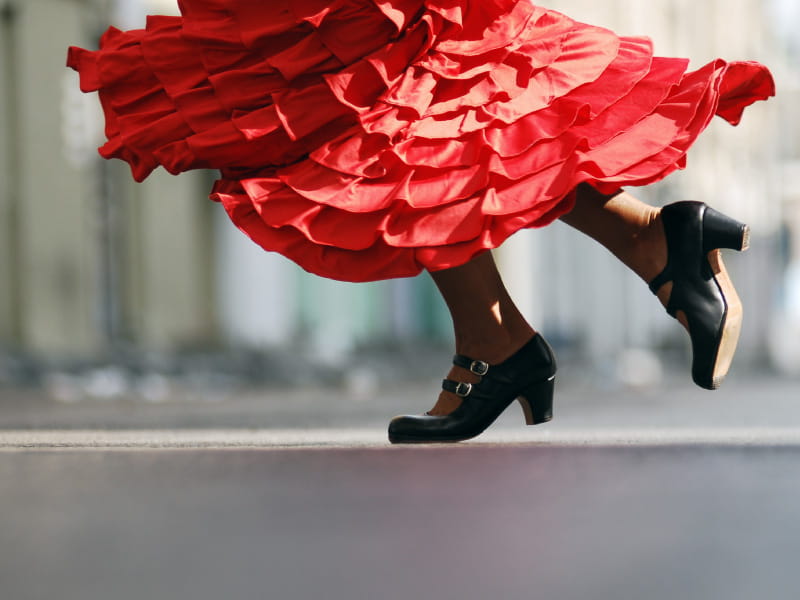Traditional dances mix music, movement, heritage and health
By Michael Merschel, American Heart Association News

Anybody who's twisted, hustled, boot-scooted or learned how to do the Dougie knows dancing can be more than just a fun way to spend a Saturday night. But when music and motion link someone to their heritage, it might provide a special kick, boosting pride, social connections and even health.
Studies have found health perks from culturally relevant dance programs that used styles as varied as Spanish flamenco, choreography to Black gospel music, and traditional Greek dances.
In Honolulu, Keawe Kaholokula has done extensive research on hula, the traditional Hawaiian dance. "We saw huge benefits – clinically, culturally, socially," said Kaholokula, head of the department of Native Hawaiian Health at the University of Hawaii at Manoa's John A. Burns School of Medicine.
Hula, which has deep historical and spiritual roots, involves synchronized body movements that illustrate accompanying songs or chants. Kaholokula and his colleagues worked with hula masters to design a program that incorporated dancing, cultural instruction and health education.
In a study of Native Hawaiians with uncontrolled high blood pressure, they found adding six months of hula lessons to heart health education led to greater reductions in blood pressure and 10-year risk of cardiovascular disease compared to those who received health education alone. The findings appeared last year in the Annals of Behavioral Medicine.
Almost any exercise can be good for heart health. But Kaholokula said the benefits of hula go beyond just getting people to move. "We think the bigger contribution is really the social and cultural impact it's having."
For a Native Hawaiian, celebrating culture through hula can provide a buffer from the pressures of being in a historically repressed group, Kaholokula said. Hula becomes a form of validation, "a place where they – their identity, the things they value – are actually valued and promoted."
Colonialization devastated Native Hawaiian culture and nearly eliminated the language. Such historic repression is a health issue, Kaholokula said, because his research has linked perceived racism to an increased risk for high blood pressure in Native Hawaiians. But people who took part in the hula program reported lower levels of perceived racism afterward, based on an ongoing analysis of data from his Annals of Behavioral Medicine study.
He thinks the program's success reflects the way it can lead to people feeling better about who they are as Indigenous people. Plus, he emphasized, "it's fun."
That's key, said David X. Marquez, a professor of kinesiology and nutrition at the University of Illinois Chicago.
Marquez is co-creator of a program that incorporates Latin dance styles – merengue, cha-cha-cha, salsa and bachata – to encourage physical activity in older Latinos. Studies found the program had a positive effect on physical activity, and dancers did better on memory and cognition tests than a control group that received only health education.
The traditional concept of exercise as something people do in a gym doesn't resonate with everybody, Marquez said. And "if people don't enjoy it or are not interested in it, then they're not going to do it."
But cultural music and dance can draw people in. In focus groups, when older Latinos talked about dance, it brought back good memories of family parties and youthful experiences, Marquez said. "It was very positive."
It also brings people together.
Dr. Amlu Natesan, a pediatric emergency medicine fellow at the University of California, San Francisco Benioff Children's Hospitals, saw this when she led a pilot study published in BMJ Open Diabetes Research & Care about how Bollywood-style dance could help with weight loss and blood sugar levels among South Asian women with Type 2 diabetes.
Being around people with similar backgrounds and health issues boosted the women's confidence and added motivation to keep participating, Natesan said. Many were exercising for the first time in their lives. Doing so to music they grew up with "definitely added a layer of connectivity."
Her interest in dance is not just clinical. She's a dancer and choreographer who, as part of a Bollywood group that has performed across the nation, including on the TV show "America's Got Talent."

Natesan was born in India and raised in the San Francisco Bay area. As she grew up in a "hybrid kind of culture," dance was a way to connect with her South Indian heritage. For immigrants looking to adapt to new surroundings without forgetting their roots, she said, music and dance can be sources of psychological comfort and community.
"My closest friends to this day are still folks who danced with me growing up – girls that I met when I was 5 years old in those early dance classes," she said.
Dance provides her with the type of focus and relaxation that other people might get from meditation. Natesan considers it "restorative," which is why she found time for it even in the busiest years of her medical training.
For people just starting out, introductions to almost any type of dance are available online. Natesan recommends finding inspiration by searching "Bollywood dance class" on YouTube, but she said professional instruction is widely available. Kaholokula said culturally appropriate hula schools can be found worldwide. Marquez suggested would-be dancers seek a local studio.
Given the health benefits, it's important for experts to continue to look at ways to engage people through dance, Kaholokula said. "The average person doesn't jog for a lifetime, or use a treadmill for a lifetime, or use a stationary bike for a lifetime. But they might do other things – like perhaps dancing."
If you have questions or comments about this story, please email [email protected].





